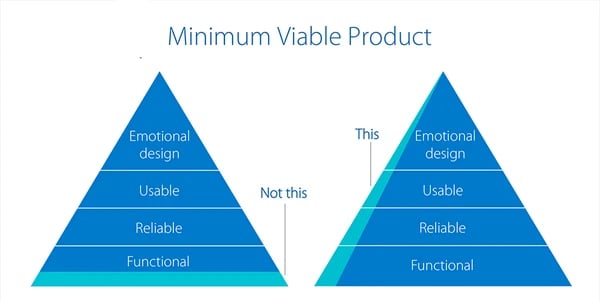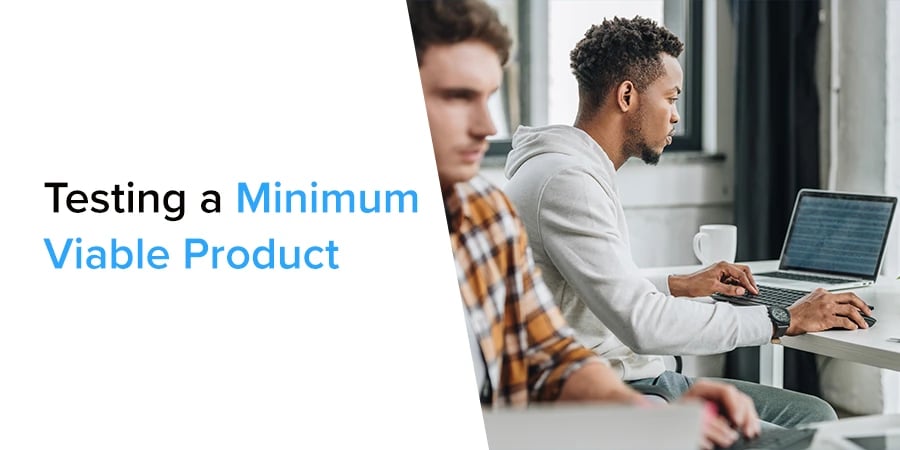Creating a Minimal Viable Product (MVP) gives businesses the opportunity to test a product idea and assess the validity or invalidity of their business plan. The idea is to create a usable prototype of the product (essentially a beta version) and release the unfinished version to prospective users.
Introduction to MVP
Questions such as “Should we continue developing this product?” or “What changes need to be made to ensure the product’s success?” can be asked after the customer feedback is collected. When this process of measuring and learning is done correctly, it will be clear that a company is either moving the drivers of the business model or not.
If not, it is a sign that it is time to pivot or make a structural course correction to test a new fundamental hypothesis about the product, strategy, and engine of growth (Source: The Lean Startup).
Make no mistake, the MVP is still a completed version of the product concept. The MVP does not, however, have the same polish or even all the features of a final product released to the market.

Source: Numovisia
One of the primary benefits of the MVP model is that it favors lean production. For bootstrapping entrepreneurs or companies favoring lean production for an unproven idea, the MVP can provide significant cost savings.
Benefits of MVP Testing
Because the MVP model is generally favored by companies looking to optimize costs, actual testing of the product’s functionality and other features can be overlooked. Nevertheless, in the digital world, the MVP represents an opportunity to gain customer validation for the product. MVP tests are designed not only to determine the viability of the product’s value proposition but also the technical elements of the product (Source: The Next Web).
Naturally, there is no point in extensively testing a largely unfinished product but there is still a place for user acceptance testing with the MVP model. Conducting validation testing on the overall platform to verify the expected outcomes and check the usability of the product makes better sense. Although the MVP is not a long-term project it remains that it should not be unusable because it is filled with bugs. Like the MVP, the testing should remain flexible and be employed only as needed.
Large-scale testing has the potential to be rendered useless in future versions of the product and therefore should be avoided through the MVP process. This testing to verify elements such as functionality and user integration can help to deliver a sound minimum viable product while still respecting cost limitations.
How to Test
User acceptance testing is considered by some to be the most important test for an MVP. Since UAT analyzes how the platform interfaces with the user and assesses if all the features of the product are clear and easy to use.
UAT also searches for bugs and other errors that can impact the user experience while they navigate through the product. Considering the average user is more concerned with the functionality of the product than its underlying structure, UAT testing becomes even more important. UAT helps to avoid the risk that functional bugs may impede users from reviewing the user interface.
The functionality of an MVP is of the utmost importance. Naturally, the MVP’s users may identify some bugs or errors but not nearly with the same precision or efficacy as a professional QA tester. Independent UAT tests ensure that most bugs are uncovered and provide the most value for developers.
In the end, the goal of the MVP is to gather user feedback and make improvements to the product accordingly. If user feedback is primarily concerned with bugs and other flaws in the product’s underlying code the MVP method will have gone to waste. Developers should ensure the product they deliver to users, although unfinished, is still stable and relatively bug-free. That way, users can focus on the features and benefits and not be constrained by technical issues.
What’s more, there is evidently ample benefit to testing a minimum viable product as it ensures the product does not just provide value to users but also is technically sound. These two equally important elements must both be true for the product to be successful. Although the MVP is a minimum version of the final product, its quality does not need to suffer.
Key Takeaways
- A Minimal Viable Product (MVP) gives businesses the opportunity to test a product idea and assess the validity or invalidity of their business plan.
- Because the MVP model is generally favored by companies looking to optimize costs, actual testing of the product’s functionality and other features can be overlooked.
- Conducting validation testing is an important part of the MVP process. It is important because beta-testers will focus on giving valuable feedback on the user interface and experience if there are no major functional bugs.
- Independent UAT tests ensure that most bugs are uncovered and provide the most value for developers.
If you are interested in learning more about testing an MVP, please do not hesitate to contact us. In addition, we invite you to download our white paper below, "How and Why to Test in the Digital Transformation Era."








